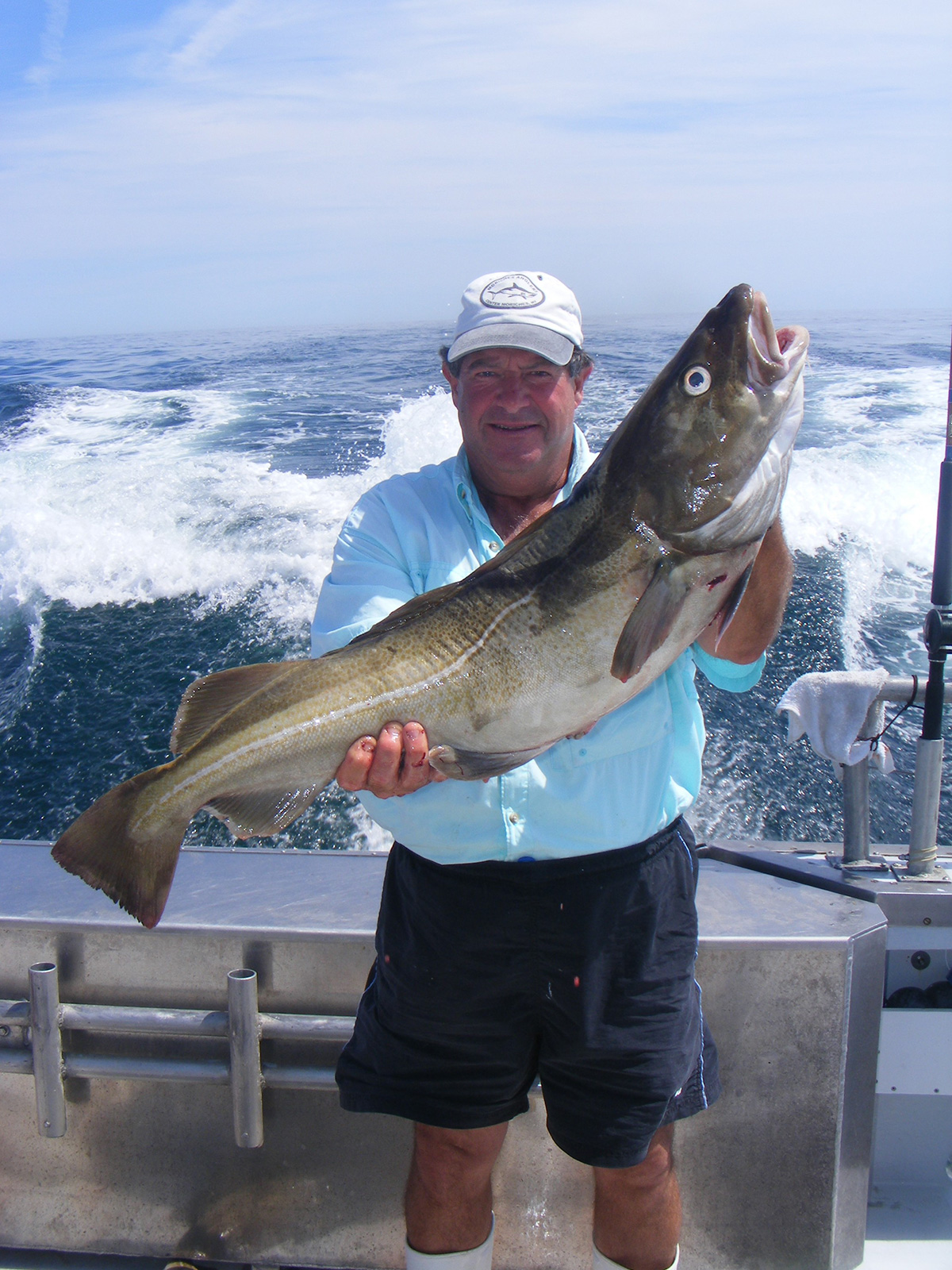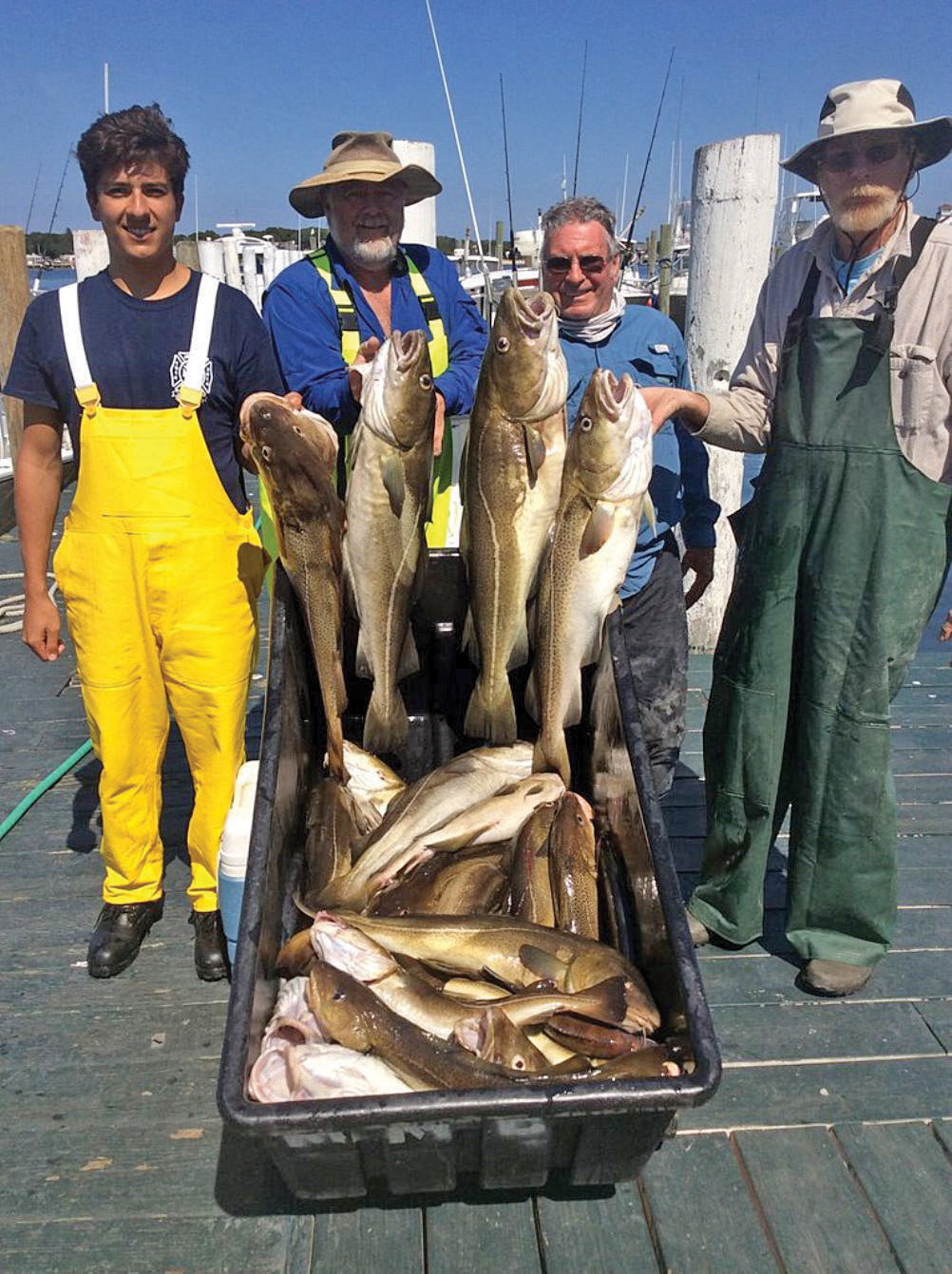
I love cod fishing, especially winter cod fishing. It’s been a winter tradition since I was a teenager back in the ‘70s. And now 40 years later, these bones of mine can’t do a fraction of what they once did. And while I don’t stand at the rail on those icy cold days as much as I once did, I thank the good Lord for giving us a summer cod fishery that at times exceeds the winter fishery in quality and consistency.
Coxes Ledge
Steam approximately 35 miles due east of Montauk Point and you’ll come to an area that rises off the sea floor like a huge shoal to 114 feet of water. Welcome to Coxes Ledge. Coxes Ledge (N41.03.000 W71.09.500) gives up nice catches of sharks and tuna during the summer months, however the big draw here is the summertime cod fishing. Boats from Long Island, Connecticut, Rhode Island and southern Massachusetts come to share the bounty.
Many anglers have asked what keeps these cod around this time of the year, since they are truly a cold blooded species. The waters off Montauk Point benefit from the confluence off the Labrador Current, which brings cold water from the North Atlantic, and the Gulf Stream, which brings warm water from the south. These currents make the region home to a wide variety of species. Due to the Labrador Current, the waters southeast of Block Island, including Coxes Ledge, remain cold the entire year, which is why codfish are caught here during the summer months.
If you are planning a trip to Coxes, you need to keep a sharp eye on the weather. This is big water, and since the ledge’s boulder and rock bottom rises above much of the surrounding bottom, waves tend to break when seas build, making for some challenging and sometimes dangerous conditions. East End waters are nothing to mess with and must be treated with the utmost respect. Stay on top of the marine forecast and plan your trips when the barometric pressure is going to hold steady for 36 to 48 hours. Watch for changing wind conditions as wind against tide (current) can generate cresting seas in a very short time. Always leave a float plan with friends or family noting the general vicinity you plan on fishing. By far the easiest and safest way to fish Coxes is aboard one of the many fine charter boats that sail from Montauk and Orient Point. Several skippers specialize in this summertime cod fishery and sailing with an experienced captain can make for a stress-free and productive trip. Be sure to check the ads in the Report Section of The Fisherman.
Heating Up
Some old salts claim that the ledge gets hot by the fourth of July. That was generally true at one time before the cod population started to decline. Then for a while, cod fishing on Coxes Ledge didn’t become really productive until the beginning of August. Recently the fishing has been slowly reverting to form, with a good bite starting sometime in late July and remaining strong through August and September. Unfortunately, the biggest menace to contend with is the proliferation of spiny dogfish. Some days, particularly early in the season, the bottom is so overrun with dogfish that it becomes impossible to fish with bait. Should that be the case, prepare to do some diamond jigging, which will produce fish, but not in the same numbers as bait. No matter what time of year you try for cod on Coxes, you will catch dogfish. Just be patient. There are times you have fish through the doggies until the cod take over. If the dogfish are a real problem, try drifting over the higher profile pieces as there are usually considerably less dogs on the high spots.

Select an Area
There are three areas of the ledge that hold the cod at various times of the year. The northern, shallower edge is an old dumping ground for derelict ships and holds at least six or so fishable wrecks. This area holds a lot less dogfish, but can also be quite sticky. The southwestern edge, where the ledge starts to drop off into deep water often produces good catches of cod. You’ll find most boats making repeated drifts over this spot, therefore if you make a pass or two with little or no success, reel up and seek greener pastures as this area receives a lot of pressure. The eastern edge also holds good quantities of cod at times. During the colder months of the year, the cod do not congregate on Coxes, though some will be caught here. When the water is cold the fish tend to spread out, and the best fishing is often found somewhere between Coxes Ledge and the southeastern side of Block Island. As the water warms the fish start to congregate up on the ledge, and the fishing peaks during the summer months.
Light but Stout
You will likely be catching mixed size cod, therefore you’re going to need a rod with some back bone and a reel to match. Rods in the 6- to 8-foot range that can handle 16 to 24 ounces of lead are a good choice, even though that much lead is not always necessary, and there are days when we have been able to fish with 12 to 14 ounces. However on other days the wind and current requires much heavier weight to hold bottom. Reels comparable in size to the Penn 112 or 113 will get the job done in the 120- to 140-foot depths. Braid is much preferred over mono, both for its sensitivity as well as to minimize the weight you will need to hold bottom. You want to keep your line as close to straight up and down as possible to avoid, or at least minimize, the snags on the bottom. The closer your line is to 90 degrees to the water, the less likely your hooks will find something to snag. The old tried and true high/low rig works along with a healthy supply of red, white and chartreuse plastic twister tails and jelly worms, which act as enticers to go along with the clam bait. Bring along a selection of hammered and smooth diamond jigs from 8 to 16 ounces since there are many days the cod switch to the natural bait for an hour and then decide they want jigs. An hour later, the bite might switch back to clam. I prefer a 30- to 40-pound fluorocarbon leader approximately 8 feet in length tied to the main line of 30- to 40-pound braid using an Albright Knot. Tie a simple sinker loop at the end of your leader and slip on a sinker just heavy enough to hold bottom. I like to tie a dropper loop chest high to the leader and slip through a super sharp Gamakatsu 7/0 Sea Hook and thread on a 6-inch Gulp! Alive Swimming Mullet in either pink or nuclear chicken. However I bring along glow, pearl white and new penny Gulp! 6-inch Swimming Mullets as standby. The benefit to this set up is that I don’t have to contend with dogfish nearly as much as with a low baited hook. On the negative side, sometimes the bait is too high and out of the feeding zone, however, over time, this system has produced a lot of quality fish.
Keep in mind that pre-rigging an assortment of rigs at home allows more time at the rail and less time re-rigging should you lose tackle or need to make changes in your approach on those picky days. And remember – this is summertime fishing so be sure to bring along the sunscreen, water and plenty of ice to keep your catch in prime condition.




